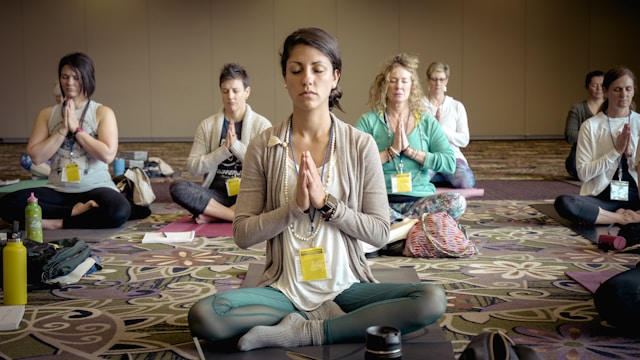A strong core is essential for maintaining good posture, yoga ball enhancing balance, and preventing injury. One of the most versatile tools you can add to your fitness routine is the yoga ball. Not only does it help engage your deep core muscles, but its unstable surface forces your body to work harder, leading to improved strength, balance, and coordination. In this article, we explore 10 effective yoga ball exercises that target your core, offering variations for beginners to advanced fitness enthusiasts. Whether you’re working out at home or at the gym, these exercises will help you sculpt a strong and stable midsection while adding variety to your routine.
1. Basic Ball Crunch
The basic ball crunch is a fantastic way to activate your abdominal muscles using the yoga ball. This exercise takes the traditional crunch and elevates it by introducing an unstable surface, which intensifies the work on your core.
How to Do It:
- Sit on the yoga ball with your feet flat on the floor.
- Walk your feet forward and roll the ball until it is positioned under your lower back.
- Cross your arms over your chest or place your hands behind your head.
- Slowly crunch upward by contracting your abs, lifting your upper body off the ball.
- Lower yourself back down in a controlled manner.
Benefits:
- Increases abdominal engagement.
- Improves balance and stability.
- Reduces strain on the lower back compared to traditional crunches.
2. Plank on the Ball
Planks are a classic core-strengthening exercise, and performing them on a yoga ball challenges your stability even more. The added instability forces your core to engage continuously, resulting in a deeper workout.
How to Do It:
- Place your forearms on the yoga ball, ensuring your elbows are directly beneath your shoulders.
- Extend your legs behind you so your body forms a straight line from head to heels.
- Hold this position, keeping your abs tight and your body rigid.
- Maintain proper form for 30-60 seconds, gradually increasing the duration as you build strength.
Benefits:
- Strengthens the entire core, including the deep stabilizing muscles.
- Enhances shoulder and upper body stability.
- Improves overall balance and coordination.
3. Ball Bridge
The ball bridge exercise not only targets your core but also works your glutes and lower back, providing a comprehensive lower body workout. This exercise is excellent for building stability and strength.
How to Do It:
- Lie on your back with your feet placed flat on the yoga ball.
- Bend your knees and lift your hips off the floor, forming a straight line from your knees to your shoulders.
- Squeeze your glutes and engage your core at the top of the movement.
- Slowly lower your hips back down without touching the floor and repeat.
Benefits:
- Strengthens the glutes, lower back, and abdominal muscles.
- Enhances pelvic stability.
- Helps in reducing lower back pain by reinforcing supportive muscles.
4. Ball Roll-Out
The ball roll-out is an advanced exercise that challenges your core and improves your balance. It mimics the movement of an ab roller but with a yoga ball, making it a highly effective exercise for the entire midsection.
How to Do It:
- Kneel on a soft mat and place your forearms on the yoga ball.
- Slowly roll the ball forward, extending your body into a straight line.
- Keep your core engaged to avoid sagging in the lower back.
- Roll out as far as you can while maintaining good form, then use your core strength to pull the ball back to the starting position.
Benefits:
- Intensively works the entire core.
- Enhances balance and coordination.
- Promotes functional strength that can translate to improved athletic performance.
5. Russian Twist with the Yoga Ball
The Russian twist is a classic core exercise that targets the obliques. Incorporating a yoga ball adds an extra element of challenge, as the instability forces you to engage your stabilizing muscles throughout the movement.
How to Do It:
- Sit on the floor with your knees bent and feet flat.
- Hold the yoga ball with both hands in front of your chest.
- Lean back slightly to engage your core, keeping your back straight.
- Rotate your torso to the right, then twist to the left, moving the ball from one side to the other.
- For added intensity, lift your feet off the ground while keeping your balance.
Benefits:
- Targets the oblique muscles for a stronger, more defined waist.
- Improves rotational strength.
- Enhances balance and core stability through controlled twisting movements.
6. Ball Pass
The ball pass is a dynamic exercise that demands full-body coordination and core strength. It involves transferring the ball from your hands to your feet and back, ensuring that every movement engages your abdominal muscles.
How to Do It:
- Lie on your back with your arms extended above your head, holding the yoga ball between your hands.
- Lift your legs off the floor to a 45-degree angle.
- Simultaneously lift your upper body off the ground, passing the ball from your hands to your feet.
- Lower both your upper body and legs back to the starting position.
- Reverse the movement by passing the ball from your feet back to your hands.
Benefits:
- Works both the upper and lower abdominals.
- Enhances coordination and functional strength.
- Provides a full-body workout that integrates core, arms, and legs.
7. Back Extension on the Yoga Ball
Often overlooked, the muscles in your lower back play a critical role in core stability. The back extension on the yoga ball strengthens these muscles while also engaging your glutes and hamstrings.
How to Do It:
- Lie face down on a mat with the yoga ball under your hips and lower abdomen.
- Place your hands lightly behind your head.
- Slowly lift your upper body off the mat, keeping your neck neutral.
- Hold the extension for a few seconds, then slowly lower yourself back down.
- Repeat for the desired number of repetitions.
Benefits:
- Strengthens the lower back and improves posture.
- Balances the muscles in your core to reduce the risk of injury.
- Enhances overall stability and athletic performance.
8. Jackknife with the Yoga Ball
The jackknife is an intense core exercise that targets your entire abdominal region. When performed with a yoga ball, it challenges your core stability and balance even further.
How to Do It:
- Begin in a plank position with your shins resting on the yoga ball and your hands on the floor.
- Engage your core and slowly roll the ball toward your chest by bending your knees.
- Continue rolling until your thighs are parallel to the floor, and your body forms a compact “jackknife” shape.
- Slowly extend your legs back to the plank position, controlling the movement with your abs.
Benefits:
- Engages the entire core, including the rectus abdominis and obliques.
- Enhances coordination and dynamic stability.
- Increases core endurance and functional strength.
9. Oblique Crunch on the Yoga Ball
To specifically target the side muscles of your abdomen, the oblique crunch on the yoga ball is a superb exercise. This movement focuses on the obliques, which are crucial for a strong, stable core and for twisting movements in everyday life.
How to Do It:
- Sit on the yoga ball and walk your feet forward until the ball is under your lower back.
- Position your body so that one side of your torso is slightly more supported by the ball.
- Perform a crunch by lifting your shoulder toward the opposite knee, twisting your torso as you do so.
- Alternate sides for a balanced workout.
- Ensure controlled movements to maximize muscle engagement and minimize strain.
Benefits:
- Isolates the oblique muscles for a more defined waistline.
- Improves core symmetry and balance.
- Aids in rotational movements that are essential for daily activities and sports.
10. Ball V-Sit
The ball V-sit is a challenging exercise that requires significant core strength and balance. This move not only works your abdominal muscles but also improves your overall stability and control.
How to Do It:
- Sit on the floor with your legs extended and the yoga ball held between your feet.
- Lean back slightly to engage your core while keeping your back straight.
- Simultaneously raise your legs and upper body, reaching for the ball with your hands.
- Form a V-shape with your body, keeping the movement controlled and deliberate.
- Lower your body back down slowly and repeat.
Benefits:
- Intensely works the entire core, including the lower abs.
- Enhances balance and stability.
- Builds endurance and overall core strength.
Conclusion
- Integrating a yoga ball into your fitness routine can dramatically improve your core strength, balance, and overall body stability. The 10 exercises outlined above provide a comprehensive approach to targeting different areas of your core—from the deep stabilizing muscles in your back to the rectus abdominis and obliques. Whether you are a beginner or an advanced fitness enthusiast, these yoga ball exercises offer scalable challenges to help you achieve your fitness goals.
- By incorporating these moves into your regular workout routine, you’ll notice improvements in posture, reduced lower back pain, and enhanced athletic performance. The yoga ball not only adds variety to your workouts but also encourages better movement patterns by challenging your body in ways that traditional exercises may not. So, roll out your yoga ball, engage your core, and start transforming your fitness routine one exercise at a time.
FAQs
Q1: Is a yoga ball suitable for beginners in core workouts?
A1: Absolutely! A yoga ball is an excellent tool for beginners because it helps engage stabilizing muscles, improve balance, and promote proper form. Start with simpler exercises and gradually progress to more challenging moves as you build strength.
Q2: How often should I incorporate yoga ball exercises into my workout routine?
A2: For best results, incorporate yoga ball exercises into your routine 2-3 times per week. This frequency allows you to strengthen your core while giving your muscles adequate time to recover between sessions.
Q3: Can these exercises help reduce back pain?
A3: Yes, many yoga ball exercises focus on strengthening the core and lower back muscles, which can help alleviate back pain by improving posture and providing better support for your spine. However, it’s always a good idea to consult a healthcare professional if you have chronic back issues.
Q4: How do I choose the right yoga ball for core exercises?
A4: Select a yoga ball that is appropriate for your height. When you sit on the ball, your knees should be at a 90-degree angle. Additionally, look for one made of durable material with a non-slip surface to ensure safety during your workouts.
Q5: What precautions should I take when exercising with a yoga ball?
A5: Always perform exercises on a non-slip surface and ensure the ball is properly inflated. Start with simpler movements and progress gradually to more advanced exercises. If you’re new to using a yoga ball, consider having a spotter or trainer guide you through the proper form.
Also read : glitter eyeshadow: 10 Must-Try Looks for Every Occasion





